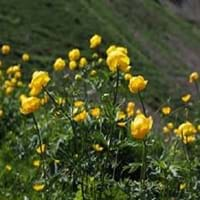Life Span
Perennial
Perennial
Type
Fruit, Tree
Herbaceous Perennial
Origin
Not Available
Central America
Types
Not Available
Trollius laxus , Trollius asiaticus , Trollius pumilus
Number of Varieties
Not Available
Habitat
Forests, gardens, Hill prairies, Homesteads, Rocky areas, Woodlands
Temperate Regions
USDA Hardiness Zone
Not Available
3-8
AHS Heat Zone
Not Available
12 - 1
Sunset Zone
Not Available
A1, A2, A3, H1, H2, 1a, 1b, 2a, 2b, 3a, 3b, 4, 5, 6, 7, 8, 9, 10, 11, 12, 13, 14, 15, 16, 17, 18, 19, 20, 21, 22, 23, 24
Habit
Bushy, Evergreen
Clump-Forming
Flower Color
Light Green, Lime Green
Orange, Yellow
Flower Color Modifier
Not Available
Bicolor
Fruit Color
Green, Light Green
Brown
Leaf Color in Spring
Yellow, Green, Gray Green
Green, Gray Green
Leaf Color in Summer
Light Green
Green, Gray Green
Leaf Color in Fall
Yellow, Green, Gray Green
Green, Gray Green
Leaf Color in Winter
Yellow, Green, Gray Green
Light Green
Plant Season
Spring, Summer, Fall, Winter
Spring, Summer, Fall
Sunlight
Full Sun, Partial Sun, Partial shade
Full Sun
Type of Soil
Loam, Sand
Loam, Sand
The pH of Soil
Acidic, Neutral, Alkaline
Neutral
Soil Drainage
Well drained
Well drained
Bloom Time
Early Summer, Summer, Late Summer, Early Fall
Early Summer, Summer, Late Summer, Early Fall, Fall
Tolerances
Pollution, Salt, Soil Compaction
Drought
Where to Plant?
Ground
Ground, Pot
How to Plant?
Seedlings, Stem Cutting, Stem Planting
Divison
Plant Maintenance
Low
Medium
Watering Requirements
Keep ground moist, Requires regular watering, Use Mulches to help prevent water loss during hot and windy weather
Keep ground moist
In Summer
Lots of watering
Lots of watering
In Spring
Moderate
Moderate
In Winter
Average Water
Average Water
Soil pH
Acidic, Neutral, Alkaline
Neutral, Slightly Acidic, Slightly Alkaline
Soil Type
Loam, Sand
Clay, Loam
Soil Drainage Capacity
Well drained
Poorly Drained
Sun Exposure
Full Sun, Partial Sun, Partial shade
Full Sun, Partial Sun
Pruning
Cut or pinch the stems, Do not prune during shooting season, Remove deadheads
Prune after flowering, Remove damaged leaves, Remove dead branches, Remove dead leaves
Fertilizers
High Potash Fertilizer
All-Purpose Liquid Fertilizer, fertilize in spring
Pests and Diseases
Bacterial Blight, Foliage-feeding caterpillars, Moth
Pest Free, Powdery mildew
Plant Tolerance
Pollution, Salt and Soil Compaction
Drought, Moisture
Flower Petal Number
Single
Single
Foliage Texture
Fine
Medium
Foliage Sheen
Matte
Matte
Attracts
Caterpillar
Butterflies
Allergy
Skin irritation
blisters, Burning sensation, Diarrhea, Irritation to intestines, Kidney Disease
Aesthetic Uses
Not Used For Aesthetic Purpose
along a porch, deck or patio, Bog Garden, Borders, Landscape Designing, Mixed Border, small hedge, Wild gardens
Beauty Benefits
Blood purifying, Glowing Skin, Good for skin and hair, Provides herbal hair care, Speed hair growth
No Beauty Benefits
Edible Uses
Yes
Sometimes
Environmental Uses
Air purification, soil stabilisation
Air purification
Medicinal Uses
Atherosclerosis, Cancer, Diabetes, Diarrhea, High blood pressure, High cholestrol, Obesity, Vitamin C
Vitamin C
Part of Plant Used
Fruits
Whole plant
Other Uses
Making Shampoo, Used for its medicinal properties, Used in herbal medicines
Traditional medicine
Used As Indoor Plant
No
No
Used As Outdoor Plant
Yes
Yes
Garden Design
Cottage garden
Cottage garden, Flower borders, Informal Garden, Showy Tree
Botanical Name
Phyllanthus emblica
GOMPHRENA globosa 'Bicolor Rose'
Common Name
Indian Gooseberry, Amla , Awala
Globe Amaranth, Globe Flower, Gomphrena
In Hindi
आमला
globe flower
In German
Stachelbeere
Trollblumen
In French
Groseille à maquereau
globe flower
In Spanish
Grosella
Trollius
In Greek
Φραγκοστάφυλλο
globe flower
In Portuguese
Groselha
Trollius
In Latin
hominem
globe flower
Phylum
Magnoliophyta
Vascular plant
Class
Magnoliopsida
Equisetopsida
Order
Malpighiales
Ranunculales
Family
Phyllanthaceae
Rhamnaceae
Genus
Phyllanthus
Trollius
Clade
Angiosperms, Eudicots, Rosids
Angiosperms, Eudicots
Tribe
Phyllantheae
Not Available
Subfamily
Not Available
Not Available
Number of Species
Not Available
Season and Care of Indian Gooseberry and Globe Flower
Season and care of Indian Gooseberry and Globe Flower is important to know. While considering everything about Indian Gooseberry and Globe Flower Care, growing season is an essential factor. Indian Gooseberry season is Spring, Summer, Fall and Winter and Globe Flower season is Spring, Summer, Fall and Winter. The type of soil for Indian Gooseberry is Loam, Sand and for Globe Flower is Loam, Sand while the PH of soil for Indian Gooseberry is Acidic, Neutral, Alkaline and for Globe Flower is Neutral.
Indian Gooseberry and Globe Flower Physical Information
Indian Gooseberry and Globe Flower physical information is very important for comparison. Indian Gooseberry height is 800.00 cm and width 400.00 cm whereas Globe Flower height is 15.00 cm and width 30.50 cm. The color specification of Indian Gooseberry and Globe Flower are as follows:
Indian Gooseberry flower color: Light Green, Lime Green
Indian Gooseberry leaf color: Yellow, Green and Gray Green
Globe Flower flower color: Orange and Yellow
- Globe Flower leaf color: Green and Gray Green
Care of Indian Gooseberry and Globe Flower
Care of Indian Gooseberry and Globe Flower include pruning, fertilizers, watering etc. Indian Gooseberry pruning is done Cut or pinch the stems, Do not prune during shooting season and Remove deadheads and Globe Flower pruning is done Prune after flowering, Remove damaged leaves, Remove dead branches and Remove dead leaves. In summer Indian Gooseberry needs Lots of watering and in winter, it needs Average Water. Whereas, in summer Globe Flower needs Lots of watering and in winter, it needs Average Water.





